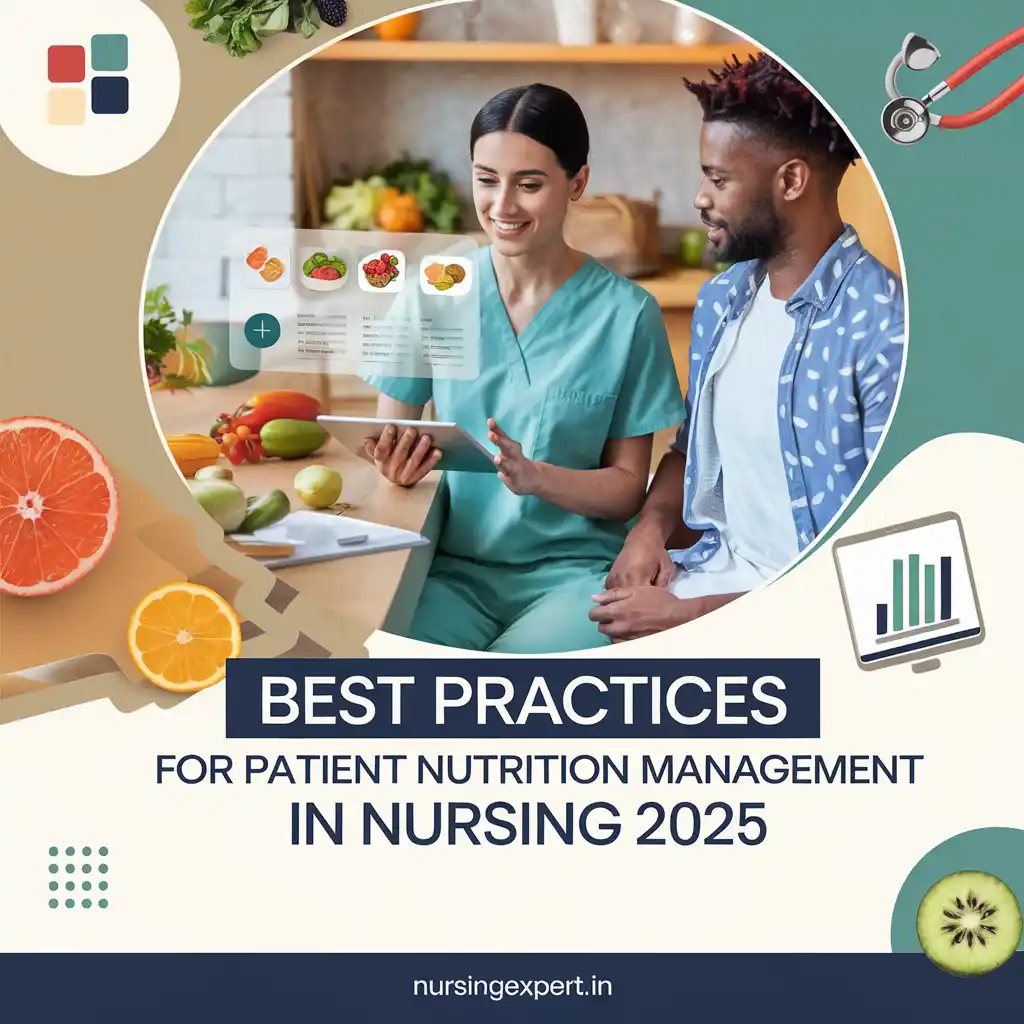Nutrition is the cornerstone of good health, playing a pivotal role in recovery, chronic disease management, and overall quality of life. In 2025, patient nutrition management is a critical aspect of nursing care that goes beyond simply feeding patients. It involves personalized assessments, effective patient education, and tailored interventions that address individual nutritional needs while considering social, environmental, and economic factors.
Thank you for reading this post, don't forget to subscribe!


Nurses, as frontline providers, are uniquely positioned to guide patients toward healthier outcomes. Their holistic approach, compassionate communication, and deep understanding of patient needs enable them to integrate nutrition management into comprehensive care plans. This article explores best practices for patient nutrition management in nursing, highlighting strategies that ensure every patient receives the optimal nutritional support to facilitate healing and well-being.
Introduction
In an era where healthcare is increasingly patient-centered, nutrition management has emerged as a key element in delivering high-quality care. For nurses, managing patient nutrition is not only about providing meals but also about understanding the intricate relationship between diet, chronic diseases, and overall health. With rising rates of chronic illnesses, an aging population, and varied socioeconomic challenges, addressing nutritional needs effectively has become more important than ever.
In 2025, nurses must balance the complexity of nutrition science with the practical realities of clinical care. This calls for a strategic, interdisciplinary approach that combines evidence-based guidelines, innovative technologies, and empathetic patient education. By doing so, nurses can ensure that patients are well-nourished, better able to recover from illness, and empowered to manage their health proactively.
Understanding Patient Nutrition Management
a. Defining Patient Nutrition Management
Patient nutrition management involves the systematic evaluation, planning, implementation, and follow-up of nutritional care aimed at promoting health, preventing disease, and supporting recovery. It is an individualized process that considers:
- Medical and Dietary History: Collecting detailed information about a patient’s past and present health, dietary habits, allergies, and food preferences.
- Nutritional Assessment: Measuring key indicators such as body weight, body mass index (BMI), blood glucose, and lipid levels to determine nutritional status.
- Individualized Care Planning: Developing care plans that integrate dietary modifications, nutritional supplements, and lifestyle changes based on the patient’s needs.
- Monitoring and Evaluation: Continuously tracking patient outcomes to adjust the plan as needed and ensure that nutritional goals are met.
b. The Role of Nutrition in Patient Health
Good nutrition is essential for healing and overall health. It contributes to:
- Immune Function: Proper nutrition strengthens the immune system, reducing the risk of infections.
- Recovery and Healing: Adequate protein and nutrient intake support tissue repair and wound healing.
- Chronic Disease Management: Diet plays a crucial role in controlling conditions such as diabetes, hypertension, and heart disease.
- Patient Energy and Strength: Nutrient-rich diets boost energy levels, enabling patients to better engage in physical therapy and daily activities.
- Mental Health: Balanced nutrition can also improve mood, cognitive function, and overall mental well-being.
Strategies for Effective Patient Nutrition Management
a. Comprehensive Nutritional Assessment
i. Multidimensional Evaluations
- Use detailed questionnaires and health history forms to gather information on dietary habits, food preferences, and potential barriers to healthy eating.
- Assess physical parameters (weight, BMI, muscle mass) and relevant lab values (blood sugar, cholesterol levels).
- Consider psychosocial factors such as living conditions, cultural practices, and economic constraints.
ii. Collaborative Goal-Setting
- Involve patients—and their families, when appropriate—in setting realistic and achievable nutritional goals.
- Discuss short-term targets (e.g., improved appetite, gradual weight gain/loss) and long-term objectives (e.g., managing diabetes, reducing cardiovascular risk).
b. Developing Individualized Care Plans
i. Tailored Nutrition Interventions
- Create personalized meal plans that cater to the patient’s nutritional needs, health conditions, and preferences.
- Integrate therapeutic diets (e.g., low-sodium, diabetic, high-protein) as indicated by the patient’s assessment.
ii. Incorporating Multimodal Strategies
- Combine dietary modifications with other interventions such as nutritional supplements and physical activity recommendations.
- Utilize complementary therapies (for example, nutrition education sessions and cooking demonstrations) to reinforce healthy habits.
c. Leveraging Technology in Nutrition Management
i. Digital Tools and Apps
- Use smartphone apps and digital platforms to track patient food intake, monitor progress, and send personalized reminders for meals or supplements.
- Provide access to educational resources and interactive tools that explain the benefits of specific diets and nutritional interventions.
ii. Telehealth for Nutritional Counseling
- Implement telehealth services to offer remote consultations, particularly for patients in rural or underserved areas.
- Enable real-time communication between patients and nutrition specialists to address concerns promptly.
d. Enhancing Patient Education and Engagement
i. Clear and Accessible Communication
- Explain nutritional concepts using plain language, avoiding medical jargon.
- Use visual aids, such as charts and videos, to help patients understand their dietary needs and instructions.
ii. Interactive and Culturally Tailored Education
- Develop educational materials that are culturally sensitive and available in multiple languages.
- Host interactive workshops or group sessions that encourage discussion and learning about healthy eating habits.
e. Supporting Interdisciplinary Collaboration
i. Coordinated Care Teams
- Work closely with dietitians, physicians, social workers, and other health professionals to develop comprehensive nutrition care plans.
- Engage in regular case conferences and team meetings to review patient progress and adjust care plans collectively.
ii. Community Partnerships
- Collaborate with local organizations, food banks, and community centers to provide resources and support for patients facing food insecurity or other nutritional challenges.
- Develop community-based initiatives that promote healthy eating, such as nutrition fairs and cooking classes.
Addressing Common Challenges in Nutrition Management
a. Overcoming Barriers to Healthy Eating
i. Economic Constraints
- Assist patients in identifying affordable sources of nutritious food, including local food banks and community-supported agriculture programs.
- Provide guidance on budgeting for groceries and making cost-effective food choices without sacrificing nutritional value.
ii. Limited Access to Healthy Options
- Advocate for improved access to healthy food in underserved areas.
- Collaborate with community organizations to create programs that bring nutritious options closer to those in need, such as mobile markets or community gardens.
b. Enhancing Health Literacy
i. Empowering Through Education
- Focus on building health literacy by explaining nutritional information in a way that is easy to understand.
- Utilize a variety of teaching methods to cater to different learning styles, ensuring that patients comprehend the importance of nutrition.
ii. Addressing Cultural and Linguistic Barriers
- Develop and distribute culturally appropriate educational materials.
- Partner with community leaders and interpreters to ensure that educational efforts are inclusive and effective.
c. Managing Time and Resources
i. Streamlined Documentation
- Use digital tools to streamline nutrition documentation, reducing the time spent on paperwork and allowing more time for direct patient care.
- Standardize assessment and reporting methods to ensure consistency and efficiency.
ii. Prioritizing Patient-Centered Care
- Balance workload by using team-based approaches that distribute responsibilities across interdisciplinary teams.
- Advocate for adequate staffing and time allocation to enable thorough nutritional assessments and interventions.
The Future of Nursing in Patient Nutrition Management
a. Integration of Technology
Digital health tools are set to play a larger role in patient nutrition management. In the near future, we can expect:
- AI-Driven Personalization: Artificial intelligence will help tailor meal plans and nutritional advice based on individual patient data.
- Enhanced Telehealth: Virtual nutrition consultations will become routine, making it easier for patients to receive timely guidance regardless of location.
- Interactive Apps: Advanced mobile applications will track dietary habits, provide meal planning advice, and offer real-time feedback to patients.
b. Expansion of Interdisciplinary Collaboration
The future of patient nutrition management will rely on strong teamwork across various healthcare disciplines. Nurses will work even more closely with:
- Dietitians and Nutritionists: Collaborating on comprehensive care plans that integrate clinical care with practical dietary advice.
- Social Workers: Addressing broader social determinants of health that influence nutritional status.
- Community Leaders: Building initiatives that promote healthy eating habits and improve access to nutritious food in local communities.
c. Policy and Organizational Support
As the importance of nutrition in patient care becomes increasingly recognized, healthcare organizations and policymakers are likely to prioritize:
- Standardized Nutrition Protocols: Development of guidelines to ensure that every patient receives evidence-based nutritional support.
- Funding for Nutrition Programs: Increased investments in community and hospital-based nutrition initiatives.
- Quality Improvement Measures: Ongoing research and performance metrics to assess the impact of nutrition management on patient outcomes, driving continuous improvement.
d. Emphasis on Patient-Centered, Holistic Care
Looking ahead, the approach to nutrition will continue to be holistic, blending physical, emotional, and social aspects of care:
- Personalized Nutritional Assessments: Using comprehensive tools to evaluate the unique needs of each patient.
- Holistic Interventions: Combining dietary recommendations with physical activity, mental health support, and social resources to promote overall wellness.
- Patient Empowerment: Fostering an environment where patients are active partners in their care, engaged in making informed decisions about their nutrition and lifestyle.
Frequently Asked Questions (FAQs)
Q1: What is patient nutrition management?
A: Patient nutrition management involves the assessment, planning, implementation, and monitoring of nutrition-related care aimed at promoting optimal health, enhancing recovery, and managing chronic conditions. It requires tailored interventions based on individual needs.
Q2: How do nurses assess a patient’s nutritional needs?
A: Nurses use comprehensive assessments that include dietary history, physical measurements, lab tests, and evaluations of socioeconomic and cultural factors to determine a patient’s nutritional status and needs.
Q3: What role does technology play in nutrition management?
A: Technology, such as mobile apps, telehealth platforms, and digital monitoring tools, helps nurses track dietary intake, provide personalized meal plans, and offer real-time support, making nutrition management more efficient and accessible.
Q4: How can nurses address economic barriers to healthy eating?
A: Nurses can connect patients with community resources like food banks, teach them cost-effective meal planning, and advocate for local programs that increase access to affordable, nutritious food.
Q5: What challenges do nurses face in managing patient nutrition?
A: Common challenges include time constraints, limited resources, low health literacy, cultural and language barriers, and the complexity of integrating nutrition into overall patient care.
Q6: How does holistic care relate to nutrition management?
A: Holistic care considers all aspects of a patient’s well-being. In nutrition management, this means addressing not just dietary habits but also the social, emotional, and economic factors that influence a patient’s ability to maintain a healthy diet.
Q7: What future trends are expected in patient nutrition management?
A: Future trends include greater integration of AI for personalized nutrition, the expansion of telehealth services for dietary consultations, more comprehensive community outreach programs, and enhanced interdisciplinary collaboration to address the social determinants of health.
Conclusion
Implementing best practices for patient nutrition management is essential for improving patient outcomes and enhancing overall well-being. In 2025, nurses are leading the way by combining comprehensive assessments, personalized care plans, and innovative digital tools to address the complex needs of their patients. By integrating holistic care principles with advanced technology and interprofessional collaboration, nurses can overcome barriers related to economic, cultural, and resource constraints.
The future of patient nutrition management is promising, with new technologies and evolving care models paving the way for more personalized and effective interventions. As nurses continue to adapt and grow in their roles, their commitment to patient-centered care will be paramount in ensuring that every individual receives the nutrition and support needed for a healthier, more vibrant life.
In essence, managing patient nutrition is not just about feeding patients—it’s about empowering them with the knowledge, resources, and support to take charge of their health. Nurses, as trusted caregivers and advocates, play a crucial role in making holistic, evidence-based nutrition management a reality for all patients.
References and Sources
- American Nurses Association (ANA). (2023). Patient Nutrition and Holistic Care. Retrieved from https://www.nursingworld.org
- Centers for Disease Control and Prevention (CDC). (2024). Nutrition and Healthy Eating Guidelines. Retrieved from https://www.cdc.gov/nutrition
- Journal of Nutrition Education and Behavior. (2023). Innovations in Patient Nutrition Management. Retrieved from https://www.jneb.or
- Institute for Healthcare Improvement (IHI). (2022). Quality Improvement Through Patient-Centered Nutrition. Retrieved from https://www.ihi.org
- Peer-reviewed articles from the International Journal of Nursing Studies and Health Affairs.
- Additional resources from the World Health Organization (WHO) and policy briefs on nutrition and public health.


